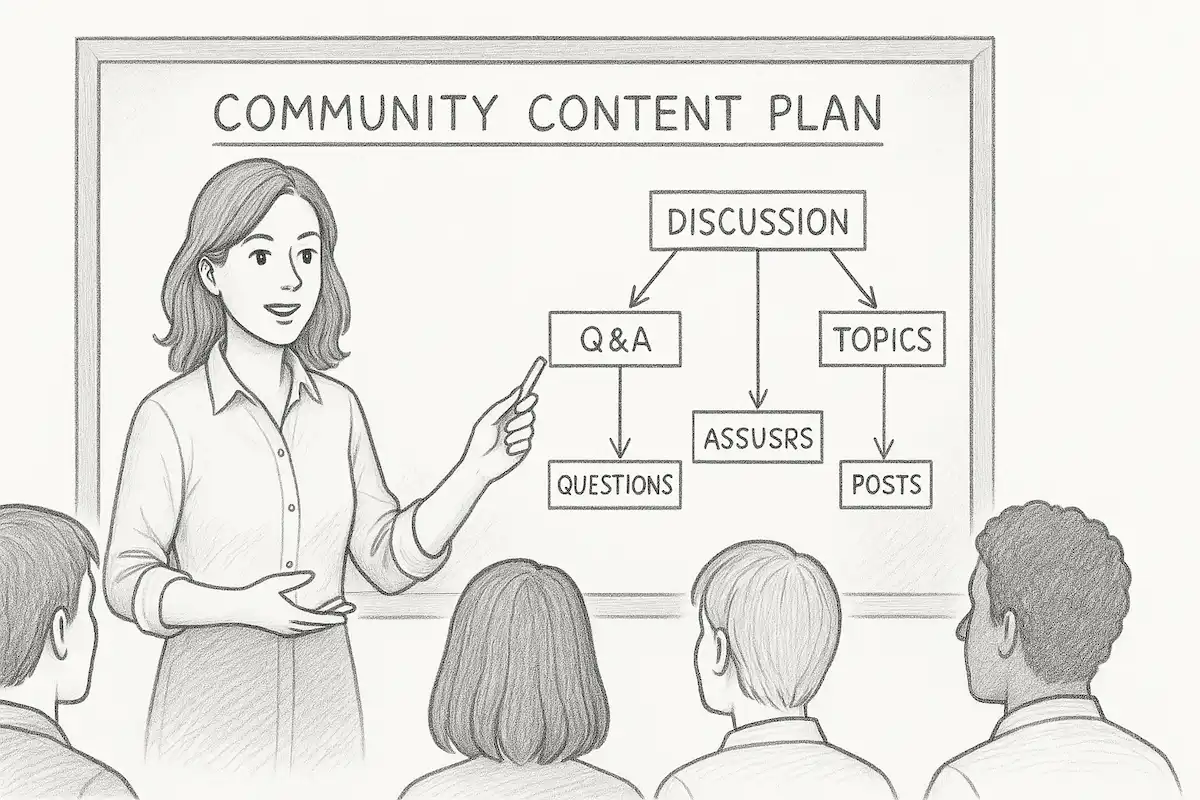Hiring a community manager can transform your community. A great hire drives loyalty and advocacy. A wrong hire can stall growth.
This guide covers the role, sourcing, skills, job description, compensation, interviews, mistakes, first 90 days, KPIs, and scaling.
The Role of a Community Manager
Many teams mistake this role for social posting. The real job connects users and the business. It is the heartbeat of your ecosystem.
Day-to-day responsibilities
- Research and create relevant content.
- Engage new and existing members.
- Run AMAs, polls, and challenges.
- Represent the brand voice.
- Handle support and resolve disputes.
- Collect feedback and share it with stakeholders.
Strategic responsibilities
- Design retention programs.
- Launch growth initiatives.
- Analyze discussions for insights.
- Implement referral programs.
- Turn members into advocates.
Collaboration is key. Work with marketing, customer success, sales, product, and engineering.
Where to Look for Community Managers
Great candidates live in communities. Not just on generic job boards.
- LinkedIn: Search creators in community building. Try
#communityand#communitybuilding. - Industry hubs: CMX, Community Hub, Jatra Community, and niche spaces.
- Reddit: r/CommunityManager.
- Community events: Attend niche meetups and conferences.
- Customer marketing groups: CMA Weekly and similar circles.
Qualities, Qualifications, and Skills
Top managers blend soft skills, hard skills, and AI fluency.
Soft skills
- Empathy: Turns rants into useful feedback.
- Communication: Bridges diverse backgrounds.
- Diplomacy: Resolves conflicts with care.
Hard skills
- Analytical: Turns data into action.
- Technical: Adopts modern platforms and tools.
- Creativity: Designs contests, rituals, and gamification.
AI skills
Use tools like ChatGPT, Perplexity, and Grok for research, analysis, and drafts. Human context still wins. Add empathy, brand voice, and relevant visuals.
Bonus skill
Comfort on camera helps. Webinars, live AMAs, and events need strong presence.
How to Write a Job Description
Specifics attract great talent. Generic JDs slow hiring.
Responsibilities
- Develop deep product knowledge.
- Understand the niche and audience.
- Create relevant content on a clear cadence.
- Track KPIs and report to stakeholders.
- Maintain active engagement.
- Encourage member-to-member connections.
- Identify and onboard champions.
- Collaborate with marketing, product, engineering, and CS.
- Resolve conflicts and nurture inclusive culture.
Required skills and qualifications
- Excellent communication and writing.
- Hands-on with community platforms and forums.
- Strong organization and analysis.
- Empathy and customer focus.
- Basic SEO, email, and content marketing.
Sample Job Description Template
Use a comprehensive template for junior and senior roles. Copy and tailor it to your needs.
Compensation and Budgeting
A well-run community delivers strong ROI. Competitive offers bring better talent.
Benchmarks
- Junior (1–3 years): $50K.
- Mid-Level (3–6 years): $68K–$80K.
- Senior (6+ years): $90K+.
Perks that help
- Remote flexibility.
- Learning budgets for courses.
- Conference stipends.
- Employee stock options.
- Quality laptop and workstation.
Great hires cut support load and lift retention and referrals.
Conducting Community Manager Interviews
Use structure. It reduces bias and reveals skill.
Step 1: Motivation and past experience
- “Tell us about a community you built.”
- “What were your top challenges?”
- “How will a community help our business?”
Seek specifics, metrics, and alignment.
Step 2: Situational questions
- “Engagement dropped 30% in a month. What do you do?”
- “Two active members are fighting in public. How do you handle it?”
Look for structure, creativity, and culture protection.
Step 3: Practical exercise
- Reply to a rant about product issues.
- Welcome a new member intro.
- Celebrate a loyal member’s achievement.
Score tone, empathy, clarity, and prompts for healthy replies.
Step 4: Business alignment
Ask, “How will you measure impact on the business?” Look for links between actions and outcomes.
Common Mistakes Hiring Managers Make
- Hiring too late. Community results take time.
- Confusing social with community. Different goals and skills.
- Writing vague JDs. Attracts the wrong candidates.
- Overloading one person. Strategy, content, analytics, and hosting need support.
First 90-day Expectations and KPIs
Give space to set foundations. Use a simple plan.
30-60-90 plan
- Days 1–30: Foundation. Define purpose, set up platform, seed content, invite a beta group. See the full plan: 30-60-90 day community launch plan.
- Days 31–60: Launch. Onboard members, start conversations, gather feedback, spark engagement.
- Days 61–90: Growth. Analyze results, refine strategy, accelerate growth.
KPIs to track
Define clear KPIs. Keep goals visible. Suggested list: KPIs for community growth.
- New member growth.
- Active users (DAU/MAU).
- Engagement rate.
- Retention rate.
- Bounce rate.
- Contribution ratio.
- Net Promoter Score.
Scaling Up Your Community Team
One manager can scale only so far. Team size follows activity.
- Add a moderator for every 100–200 weekly active posters.
- Add one support teammate for every 5,000 registered members.
Consider event leads, analytics partners, and ambassador programs.
Wrapping it Up
The right community manager is a major asset. Hiring well takes clarity and intent.
Have questions on hiring? Join discussions with community managers and owners in our official community.
